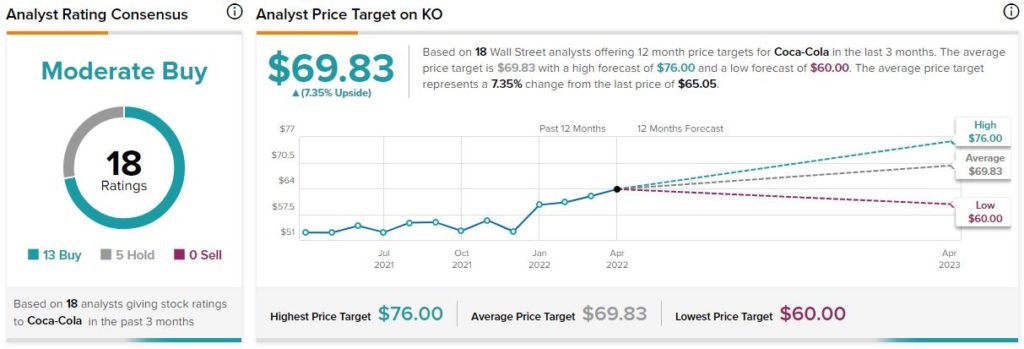- Aprile 28, 2022
- Posted by: Oliver
- Categoria: Economics, Finance & accounting

The Coca-Cola Company (KO) offers non-alcoholic beverages, including sparkling soft drinks, water, enhanced water, sports drinks, juice, tea, energy drinks, and more.
Its key brands include Coca-Cola, Costa Coffee, Fanta, Sprite, Minute Maid, Georgia, Powerade, Fairlife, Schweppes, Aquarius, and Dasani, among several others.
Since the company operates internationally and manages many products, the management team’s commentary on how they view the economy can offer investors some useful information on what to expect going forward.
So far, Coca-Cola has been able to effectively handle inflation by passing on costs to consumers. However, it remains to be seen how long the company can get away with doing this.
Although Coca-Cola had an excellent quarter, we are neutral on the stock due to its valuation.
Coca-Cola and Inflation
Coca-Cola is considered a consumer staple as it provides consumers with some of their favorite drinks. As a result, the company can hedge rising costs by passing them along to consumers in order to protect its margins.
However, in KO’s earnings call, management highlighted how this might not always be the case in the future.
CEO James Quincey stated, “It has been apparent, and other people have commented on less elasticity in recent times as price increases have gone through. I do not expect elasticities to be inelastic going forward. There’s a reason you got the name elasticity. And so I fully expect, as I commented earlier on, inflation generally ends with some pressure somewhere. I expect elasticity to increase at some point in the future.”
Quincey stressed the importance of affordability and price points. He does not want to simply hike prices without considering competitors’ pricing. Therefore, it is important for the company to mitigate costs through innovation and packaging to stay price competitive.
James Quincey also kept reiterating that it is crucial for the company to earn the right to raise prices. As a result, Coca-Cola has been investing more in marketing in order to stay in front of its competitors.
This suggests that higher inflation may force companies to spend more on marketing to justify the price increases. However, this scenario may be more applicable to larger businesses that have the deep pockets to meaningfully increase marketing spending.
Smaller companies could be forced to cut back on marketing spending because it might not make a meaningful enough impact on sales. In such a scenario, cutting marketing costs would be a way for smaller companies to maintain their competitiveness in pricing while also protecting margins.
Nevertheless, this does come at a cost for the smaller players as it could mean that they will lose market share. As a result, it’s reasonable to assume that large, well-established corporations have an advantage in the current macroeconomic environment. In addition, it appears that advertising companies might actually benefit from higher inflation as companies attempt to justify higher prices.
Valuation
To value Coca-Cola, we will use a single-stage DCF model because it is a mature company that is likely to grow in the low single digits over the next decade. For the terminal growth rate, we will use the 30-year U.S. Treasury yield as a proxy for expected long-term GDP growth.
Our calculation is as follows:
Fair Value = Average FCF per share / (Discount Rate – Terminal Growth)
$56.67 = $2.61 / (0.075 – 0.0289)
As a result, we estimate that the fair value of Coca-Cola is approximately $56.67 under current market conditions. With KO currently trading near $65, the stock is potentially overvalued.
Dividends
In our previous Coca-Cola article, we mentioned that we believed the dividend yield was too low because it was trading near the bottom end of its historical range. Unfortunately, Coca-Cola’s yield has shrunk slightly since then, falling to ~2.6% from 2.73% on a trailing 12-month basis.
Although the forward yield is 2.7% (when annualizing the current quarterly payout), it’s still at the bottom end of its historical range.

Furthermore, Coca-Cola has a payout ratio of 95.3%, which means that it is limited in how much it can raise its dividend. It can really only raise its dividend by the same amount as its earnings growth. Therefore, we don’t believe that income investors are getting a good deal at this price.
Wall Street’s Take
Turning to Wall Street, Coca-Cola has a Strong Buy consensus rating based on 13 Buys, five Holds, and zero Sells assigned in the past three months. The average Coca-Cola price target of $69.83 implies 7.4% upside potential.

Final Thoughts
Coca-Cola is definitely a strong business with great brands under its umbrella. Although it has been able to weather inflation well, there doesn’t appear to be much upside left based on analysts’ estimates.
In addition, the company appears to be slightly overvalued based on our estimates. As a result, we are neutral on the stock.
